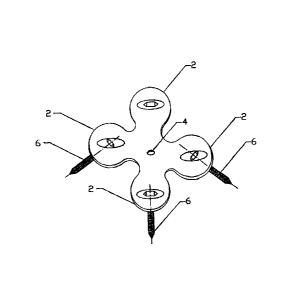Note: Descriptions are shown in the official language in which they were submitted.
CA 02816792 2013-04-12
Description
Field of the Invention: The Tether Plate with its two extensions (2) on each
side,
which can accept 4mm screws (6) through the holes (3), would provide a
temporary physical growth arrest in a child's growing bone. By using this
Tether
Plate, an Orthopaedic surgeon can do a guided inhibition of the growth plate.
Background: Interest in mechanical disruption of abnormal physical growth of
bone is as old as the concept of permanent surgical of epiphysiodesis. Similar
devices and materials, such as Wire by Haas [a], Staples (one to three) by
Blount
[c], and Trans-Physical Screw by Metaizeau et al [b], have been used to
shorten a
bone growth or correct its angulations. But, many complications, such as
implant
failure (wire breakage, staple extrusion or breakage), recurrence of
deformity, and
inadvertent angular deformity because of eccentric insertion of staples or
screws
[d-g] have been reported in literatures.
Recently, a new method by using an 8 like plate has been reported by Stevens
et al
(7). This plate affords only a point like tether on the physics and, if
inserted
eccentrically, there could be a theoretical risk of undesired guided growth
associated with it.
Similarly, the X-Plate by Beutter et al [h] was invented for fracture
fixation. It
lacks a central hole and since the plate has a slight curvature towards its
inside, the
screws converge to a single point. This significantly limits an Orthopaedic
surgeon's flexibility and makes it very difficult for the surgeon to precisely
locate
and install the plate.
Summary of the Invention: Unlike the above mentioned similar devices, the
described Tether Plate spreads the point area of tether effect to a wider area
and
eliminates the possibility of some iatrogenic complications. As a result, the
same
results would be achieved regardless whether the Tether Plate is installed on
slightly posterior or anterior aspects of the growth plate.
The central hole (4) provides the surgeon with the ability to precisely locate
the
Tether Plate over the bone growth plate and the multi-directionality of the
holes (3)
ensures the screws (6) are inserted parallel to the growth plate, as opposed
to
converging to a point.
Page 1 of 3
CA 02816792 2013-04-12
BRIEF DESCRIPTION OF THE DRAWINGS
Having thus described the invention, reference will now be made to the
attached
drawings, which are not necessarily drawn to scale:
Fig 1 shows schematically a top view of the Tether Plate identifying different
sections of the Plate.
Fig 2 shows a cross section of the Tether Plate and its different sections.
Fig 3 shows an isometric view of the Tether Plate and its different sections.
DETAILED DESCRIPTION OF PREFERRED DRAWING
The plate is composed of four identical extensions (2), as shown in Fig 1,
which
I are attached to the central body (1). Each extension has a 4mm smoothly
tapered
and bevelled holes (4-5) via which fixation of the Tether Plate to the bone
through
four screws (6) could be done(Fig 3). The width of the extensions is 11 mm
with a
3006 mm radius filleted steep around the hole, as shown in Fig 2. The central
body
(1) of the Tether Plate is 12 mm in diameter and has a central hole of 1.5 mm.
The
central hole can take a 0.8 mm guide pin, which can be used to locate the mid
antero-posterior point of the growth plate under fluoroscopic control. The
center to
center vertical distance between two holes (2) is 16 mm for adolescent and 14
mm
for children 10 years old and under. The thickness of the plate is 2 mm, as
shown
in Fig 2.
Page 2 of 3
